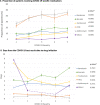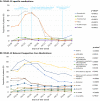Pharmacotherapy for Hospitalized Patients with COVID-19: Treatment Patterns by Disease Severity
- PMID: 33151482
- PMCID: PMC7643089
- DOI: 10.1007/s40265-020-01424-7
Pharmacotherapy for Hospitalized Patients with COVID-19: Treatment Patterns by Disease Severity
Abstract
Background: Treatment decisions for Coronavirus Disease 2019 (COVID-19) depend on disease severity, but the prescribing pattern by severity and drivers of therapeutic choices remain unclear.
Objectives: The objectives of the study were to evaluate pharmacological treatment patterns by COVID-19 severity and identify the determinants of prescribing for COVID-19.
Methods: Using electronic health record data from a large Massachusetts-based healthcare system, we identified all patients aged ≥ 18 years hospitalized with laboratory-confirmed COVID-19 from 1 March to 24 May, 2020. We defined five levels of COVID-19 severity at hospital admission: (1) hospitalized but not requiring supplemental oxygen; (2-4) hospitalized and requiring oxygen ≤ 2, 3-4, and ≥ 5 L per minute, respectively; and (5) intubated or admitted to an intensive care unit. We assessed the medications used to treat COVID-19 or as supportive care during hospitalization.
Results: Among 2821 patients hospitalized for COVID-19, we found inpatient mortality increased by severity from 5% for level 1 to 23% for level 5. As compared to patients with severity level 1, those with severity level 5 were 3.53 times (95% confidence interval 2.73-4.57) more likely to receive a medication used to treat COVID-19. Other predictors of treatment were fever, low oxygen saturation, presence of co-morbidities, and elevated inflammatory biomarkers. The use of most COVID-19 relevant medications has dropped substantially while the use of remdesivir and therapeutic anticoagulants has increased over the study period.
Conclusions: Careful consideration of disease severity and other determinants of COVID-19 drug use is necessary for appropriate conduct and interpretation of non-randomized studies evaluating outcomes of COVID-19 treatments.
Conflict of interest statement
Dr. Schneeweiss is participating in investigator-initiated grants to the Brigham and Women’s Hospital from Bayer, Vertex, and Boehringer Ingelheim unrelated to the topic of this study. He is a consultant to Aetion Inc., a software manufacturer of which he owns equity. His interests were declared, reviewed, and approved by the Brigham and Women’s Hospital and Mass General Brigham System in accordance with their institutional compliance policies. Dr. Gagne has received salary support from grants from Eli Lilly and Company and Novartis Pharmaceuticals Corporation to the Brigham and Women's Hospital and was a consultant to Optum, Inc., all for unrelated work. Other authors have no conflict of interest to disclose.
Figures


References
-
- Roser M, Ritchie H, Ortiz-Ospina E, Hasell J. Coronavirus Pandemic (COVID-19). Published online at OurWorldInData.org; 2020. https://www.ourworldindata.org/coronavirus. Accessed 16 June 2020.
MeSH terms
Substances
LinkOut - more resources
Full Text Sources
Medical
Research Materials

